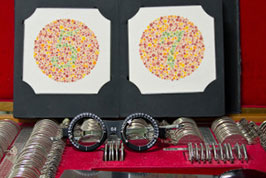Color Blindness: Its Symptoms, Diagnosis And Treatment


Dr. Naseem Fakhereddeen, Specialist in Ophthalmology, gives us an insight on Color Blindness
In the retina (the light-sensitive tissue lining the back of the eye), there are two types of cells that detect light: rods and cones. Rods detect only light and dark and are very sensitive to low light levels. Cone cells detect color and are concentrated near the center of your vision. There are three types of cones that see color: red, green and blue. The brain uses input from these three color cone cells to determine our color perception.
Color blindness can occur when one or more of the color cone cells are absent, nonfunctioning, or detect a different color than normal. Severe color blindness occurs when all three cone cells are absent, and mild color blindness occurs when all three cone cells are present, but one cone cell functions abnormally to detect a different color than normal.
There are different degrees of color blindness. Some people with mild color deficiencies can see colors normally in good light but have difficulty in dim light. Others cannot distinguish certain colors in any light. The most severe form of color blindness, in which everything is seen in shades of gray, is uncommon. Congenital color blindness usually affects both eyes equally and remains stable throughout life.
Symptoms
The symptoms include:
Except in the most severe form, color blindness does not affect the sharpness of vision. Most people with color blindness are born with it. (This is called a congenital condition.) Most color vision problems that occur later in life are a result of disease, trauma, toxic effects from drugs, metabolic disease or vascular disease. Disease-specific color blindness often affects both eyes differently, and the color vision defect usually gets worse over time. Acquired color vision loss can be the result of damage to the retina or optic nerve.
Diagnosis and treatment

A simple test consists of showing the patient a pattern made up of multi-colored dots. If the patient does not have a color deficiency, he will be able to see numbers and shapes among the dots. If he is color blind, he will have a hard time finding the number or shape in the pattern or may not see anything in the pattern at all.
There is no treatment for congenital color blindness. It usually does not cause any significant disability. However, there are special contact lenses and glasses that may help people with color blindness tell the difference between similar colors.
Acquired forms of color blindness may be treated by addressing the underlying condition or drug that caused the problem.
Source:http://youandeyemag.fourplusmedia.com/color-blindness-symptoms-diagnosis-and-treatment/